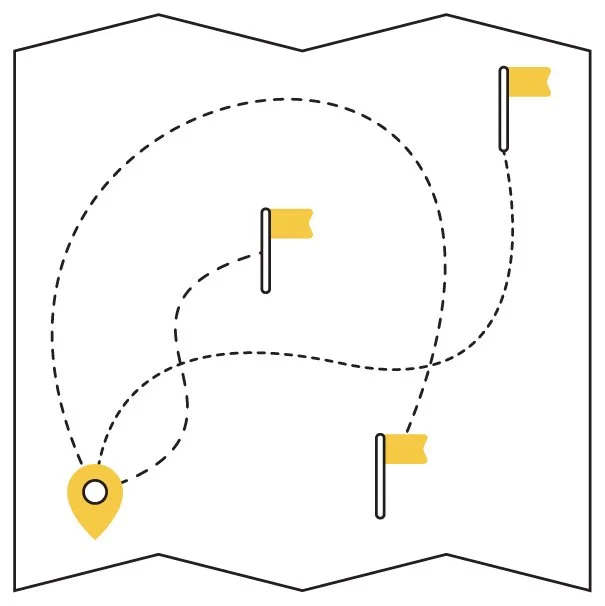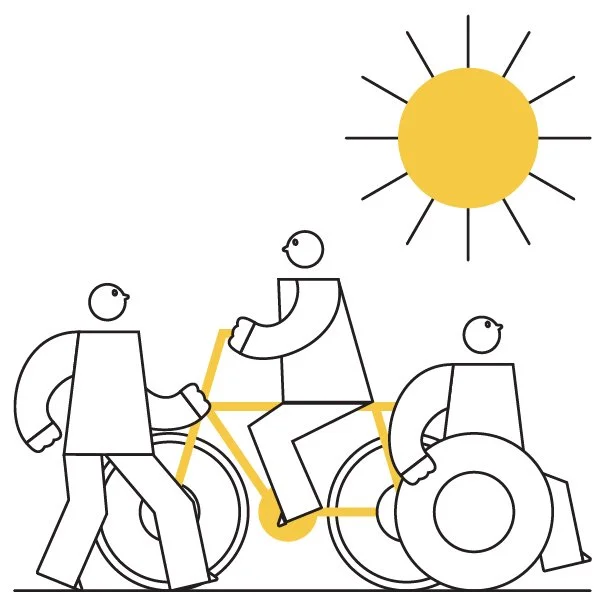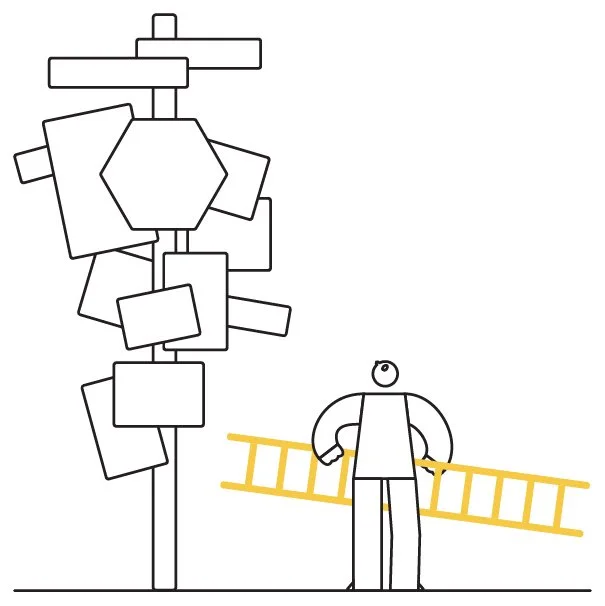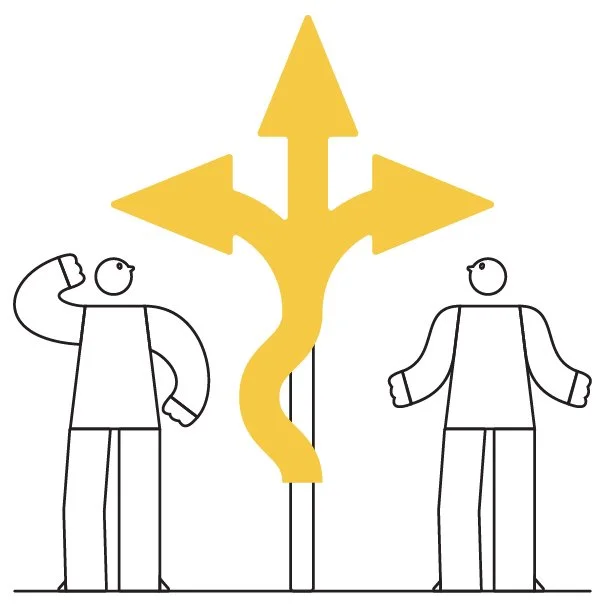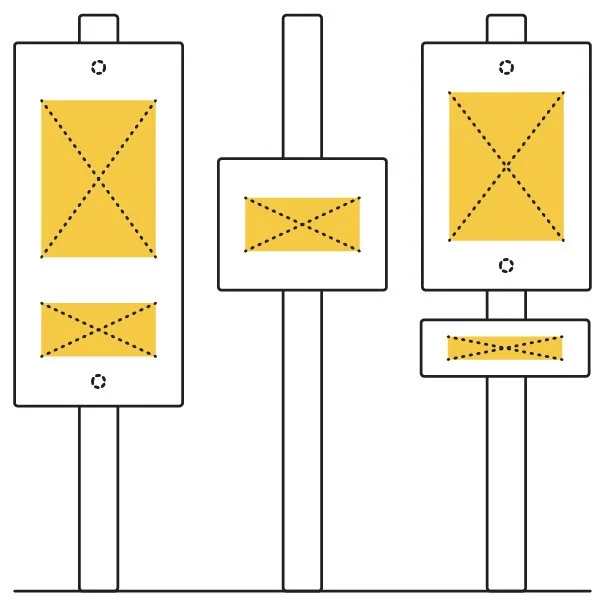
Six Steps to Success
We’ve done the hard work for you with a step by step approach. Choose from our Service Levels and get access to simple templates and instructions that walk you through the planning process.
Online video tutorials coming soon—watch this space!
〰️
Online video tutorials coming soon—watch this space! 〰️
1
Define Your Users and Destinations
Who is it for and what do want them to find?
Start by determining your audience and being able to identify the places and things they are looking for. This creates the foundation for a great wayfinding strategy.
When thinking about the people visiting your city, try to be a specific as possible. It's natural to want your signage to serve everyone—and it will! However, thinking through those niche audiences will help to make your signage more tailored to the needs of your community. For example, what a tour group is looking for might be different than a young family.
Once you are clear on who the wayfinding signage is serving, make a list of the things they are looking for and what’s the best your city has to offer. Your list of destinations might be relatively simple and short. If the list is longer, we recommend making categories to help organize and make clear all the important destinations for your city.
2
Map Routes for All Users
Which ways do they go? Is it different on foot or wheels?
This is one of the fun parts. What you want to do here is put yourself in the place of each of the user groups you identified in Step 1. Then you will create what we like to call “imaginary journeys.” Don’t worry, it’s completely legal.
An imaginary journey can have multiple starting points and ending points, but it is the process of finding one’s destination that is the key to wayfinding success! For example, once someone arrives whether by car, bike or on foot, how will they orient themselves? You know, when you look at a map and an X marks were you are, that is orientation!
Consider whether a specific route is for pedestrians on foot or on wheels. Are there stairs that make the route inaccessible and will it be necessary to point people in wheelchairs or with strollers toward a different path? Cyclists may have separate pathways of travel, separated from both pedestrians and vehicles and may require a separate exercise of developing “imaginary journeys.”
3
Start Decluttering
What signs can you fix up what can be removed?
Over time it is natural for any city to accumulate a variety of signs. These signs no doubt were put in place to address particular needs. But do they still spark joy? Because of the ad hoc way they can get added over time, a collection of signs doesn't always work together and can make wayfinding more confusing. Sign clutter creates a less than welcoming place for visitors and locals.
A sign “audit” will help you understand what signs already exist and where these signs are located. Once that is done, you can make a list of signs to be either removed or replaced in conjunction with your all your new wayfinding signs!
4
Decision Points and messages
Where do they need to turn and what do they need to know?
An important part of your wayfinding system is determining what your signs say and where they go. Take what you learned from the imaginary journeys in Step 2 to determine arrival and decision points. Signs will be required at both of these points, for example.
Using our worksheets, determine what each sign needs to say. We call the text on signs “messages.” This is the critical information on signs that will be communicated to your audience as they navigate your city. The messages come straight from your destination list in step 1. For example, you have identified a certain decision point may require a directional sign pointing the way to downtown parking. This requires a directional sign pointing to “Downtown,” perhaps even with a parking or EV-charging station icon.
If the route isn’t straightforward, or you can’t easily see the destination, one will find “forks in the road.” These “forks” are the next decision points, which is often a great place for a subsequent directional sign. It’s like breadcrumbs! Finally, once someone has arrived to their destination, will it be clear? If it is not clear, this is another great place for a sign identifying that they have arrived at their destination.
5
Choose a sign
How big does it need to be and what goes on it: maps, rules, icons?
There are some essential sign details in addition to messages. For example, how big should your sign be? This will depend on the distance the sign needs to be seen along with how fast will your audience will typically be moving. Generally speaking, the bigger both these numbers are, the bigger the sign needs to be. At the same time no one wants “highway signs” everywhere. People need to see the good stuff your city has to offer!
The Public Wayfinding Kit contains over a dozen different sign types for different uses and we can assist you in choosing the right one. There are a host of icons that might want to include on our signs, for everything from public washrooms to picnic areas.
Some signs include walking area maps. These are extremely useful for moments when people have parked their cars and are looking to orient themselves and discover what is close by. The Public Wayfinding Kit maps always include a clear “You Are Here” arrow that points you the direction you are facing. In addition, we include a circle around this marker that shows you roughly where you can walk to in a few minutes. This really helps people feel comfortable to get out and explore!
6
Add your brand
Customize a template with your colours and logo — the best part!
Last but not least you will want to "brand" your signs. This will be valuable part of building your city's “look and feel.” We have a several template options to choose from and ways those designs can be tailored specifically to your city's brand colours or by adding your logo. At the same time we will ensure that any colour choices don't undermine the legibility of your signs. Our experts will do digital colour blindness testing and perform other best practices reviews on your order before we fulfill it.
At the end of the day we want to ensure your wayfinding system is clear and informative and makes your city easy to navigate for a variety of audiences.
Need more help? We offer custom levels of expert support including stakeholder and public engagement for wayfinding and on-site review of your current signage with an eye to doing a renovation. Email us to discuss your planning requirements.

